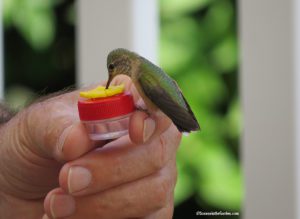Sept. 22 Column: Attracting Birds to the Garden

Aren’t birds just the coolest creatures around? My husband and I are avid birdwatchers. We made it an early priority to landscape with the idea of attracting birds to our garden.
That’s the topic of today’s garden column, which you can read in The Spokesman-Review: Planting for the birds reaps many rewards. You can also read it below. And don’t miss this week’s video on the same topic underneath it!
As I mention in my column, we have counted over 90 different species of birds that come for a visit to our garden. And they often nest here as well. Two years ago, I created a Birds in the Garden guide, which includes profiles of the birds we’ve observed.
The bird in the photo above is a male Western bluebird. They are insectivorous and extremely successful at hunting insects. They’re one of my favorite residents during the spring and summer months. The photo at the very top of this post is of one of our American cranberry bushes (Viburnum trilobum). They are a fantastic, berry-producing shrub that the birds adore in the winter.
I hope both my column and the guide will give you ideas of ways to attract birds to your own garden. They are such a joy to watch! Many of them eat insects so they can be your allies in the garden. That’s a win-win situation, right?
And just in case you never saw this photo on my Facebook page a while back… Here is Bill feeding a Calliope hummingbird with a miniature feeder. Is this cool or what?!

Column:
This summer, my husband, Bill, and I have been treated to some delightful interactions with the birds in our garden:
- enticing hummingbirds to sit on our fingers while they sipped from tiny feeders
- observing baby quail blissfully napping in the shade of the daylily patch
- listening to the whistling calls of a family of cedar waxwings
- and gardening to the tunes of a male catbird as it ran through its repertoire of other birds’ calls
None of this would have taken place if we hadn’t made our landscape attractive to birds over the years. When we first bought our 5-acre lot, the landscape consisted of a foot-tall ponderosa pine. Just one tree. My, how things have changed.
While the wide open spaces were somewhat appealing, we knew it wouldn’t make birds feel safe. Over time, we planted tall and short trees. We also added native shrubs that produce berries or provide shelter. And we planted a range of annuals and perennials. Those provide either nectar for hummingbirds or seedheads for birds to feast on during the colder months of the year.
This varied landscape offers places for them to duck into when a hawk flies through, roost in at night, or opportunities for building a nest and raising a family. When we watch the birds living and/or feeding in our garden, it gives us a sense of satisfaction knowing we had a hand in this.
Bill and I once made a list of the birds we’ve seen here and stopped counting at 90 species. These include white-crowned and song sparrows, Western bluebirds, swallows, crossbills, robins, chickadees, Northern flickers, downy and hairy woodpeckers, wrens, juncos, California quail, goldfinches, grosbeaks, Cooper’s hawks and nuthatches.
Water features are another draw for birds, since drinking and daily bathing are a necessity for good health. In addition to two birdbaths, we have a large pond with a waterfall (splashing water is a bird magnet) and a small pond.
When it comes to the food we put out for the birds, it mainly consists of black-oil sunflower seeds, suet, nectar for the hummingbirds and Nyjer thistle during the winter.
As I mentioned above, there are plenty of plants within our garden that also feed the birds. The berries on American cranberry bushes, serviceberries, snowberries, red Osier dogwoods, black currants and chokecherries are some of their favorites. All are native shrubs.
The hummingbirds are more than happy to seek out nectar in the flowers of penstemon, bee balm, red hot poker, honeysuckle and annual salvia.
When it’s time for fall clean-up of the flower beds, I take a laid-back approach in favor of the birds by leaving seedheads for them. The seeds found inside are an important source of nutrition during the fall and winter months. I’ve noticed their favorites are bee balm, globe thistle, coneflower, sunflower, black-eyed Susan and Gloriosa daisy.
Another favorite of our bird friends is the seeds of lavender plants. There is nothing quite like walking past the lavender patch in the dead of winter, with snow piled high all around, and smelling the distinctly pleasant fragrance of lavender after the birds have nibbled on the seeds. It’s not difficult to attract birds to your garden. By providing shelter from predators and the weather, trees and shrubs of varying heights for nesting, water for drinking and bathing, and food sources, you will have made them feel welcome. Your reward will be watching them and knowing you’ve improved the environment surrounding your home.
This week’s video:
For this week’s “Everyone Can Grow a Garden” video, I felt it would be helpful to continue the bird theme by actually showing you what we’ve done in our own landscape and examples of many of the trees and shrubs we chose. I hope you’ll enjoy it:

